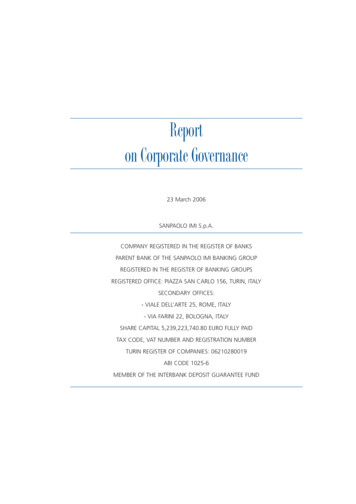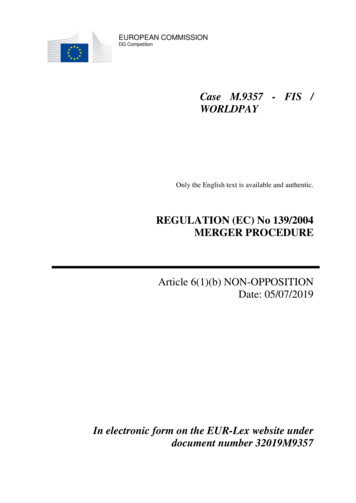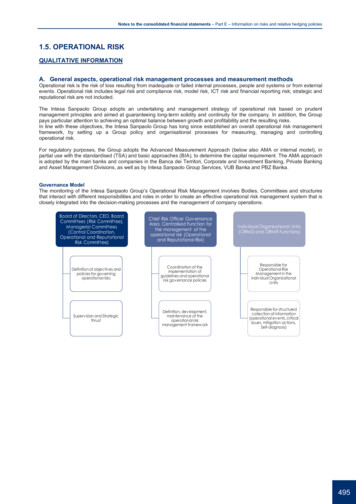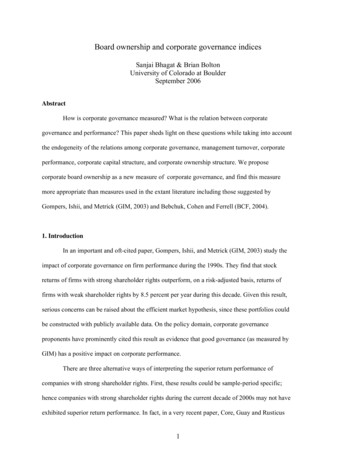
Transcription
Reporton Corporate Governance23 March 2006SANPAOLO IMI S.p.A.COMPANY REGISTERED IN THE REGISTER OF BANKSPARENT BANK OF THE SANPAOLO IMI BANKING GROUPREGISTERED IN THE REGISTER OF BANKING GROUPSREGISTERED OFFICE: PIAZZA SAN CARLO 156, TURIN, ITALYSECONDARY OFFICES:- VIALE DELL’ARTE 25, ROME, ITALY- VIA FARINI 22, BOLOGNA, ITALYSHARE CAPITAL 5,239,223,740.80 EURO FULLY PAIDTAX CODE, VAT NUMBER AND REGISTRATION NUMBERTURIN REGISTER OF COMPANIES: 06210280019ABI CODE 1025-6MEMBER OF THE INTERBANK DEPOSIT GUARANTEE FUND
Index5 Introduction7 Part I - Company and Group profile8Organization10Composition of share capital, majority shareholders and agreements between shareholders12The role of the Parent bank and the SANPAOLO IMI Group17 Part II - Governance System and information on the implementation of the Code of Conduct18Board of Directors18Composition and duration18Executive and non-executive Directors - the Chairman and the Deputy Chairman18Independent Directors20Offices of Director or Statutory Auditor held in other companies20Functions of the Board of Directors21Board meetings22Executive Committee22Technical Committees22Technical Audit Committee24Remuneration and Personnel Policies Technical Committee24Ethical Committee25Nomination of the Directors25Remuneration of the Directors and Top Management26Managing Director, General Manager and Organizational Structure27Other Committees27Group Credit Committee27Group Financial and Market Risk Committee28Group Operational Risk Committee28Disclosures Committee28The financial reporting control system29The internal control system30Organization, Management and control model pursuant toLegislative decree No.231/2001 and relative Regulatory Body31Transactions with related parties32Treatment of confidential information33Internal dealing and insiders list33Relations with shareholders and the financial community34Shareholders’ Meetings36Board of Statutory Auditors36Nomination, composition and duration36Functions and powers of the Board of Statutory Auditors37Offices of Director or Statutory Auditor held in other companies39Audits41 Part III - Summary Tables49 Attachement*Articles of Association
The entrance of the headquarters of SANPAOLO IMI in piazza San Carlo in Turin
Corporate Governance — IntroductionIntroductionSANPAOLO IMI has adhered to the aims and indications ofthe Code of Conduct for Listed Companies from its issue,recognizing the validity of the corporate governance modeldescribed therein.The Company has implemented operating guidelines in linewith the principles described in the Code and Consob recommendations on the matter, as well as with domesticand international best practices in general, adopting a governance system that aims to guarantee adequate sharingof responsibilities and powers, correctly balancing the functions of management and control 1.On 12 January 2006, law no. 262 of 28 December 2005,“Provisions for the protection of savings and for the regulation of financial markets” became effective (the so-called“Law on Savings”), aimed at ensuring greater transparencyto regulated markets and increasing the protection of savings. The law introduced significant innovations in terms ofcorporate governance. For example, by 12 January 2007, listed companies must include in their Articles of Associationchanges aimed at providing for a voting list for nominationof the board of directors, with the requirement that at leastone of the directors be from the list of minority shareholders;in addition, it must be established that the Chairman of theBoard of Statutory Auditors be nominated - in accordancewith the procedures established by Consob - from amongthe auditors elected by the minority shareholders.Being a company registered with the U.S. Securities and Exchange Commission (SEC) and an issuer of listed financialinstruments on the New York Stock Exchange, the SANPAOLO IMI governance system also reflects the provision of U.S.standards on the matter, contained in the 1933 SecuritiesAct, the 1934 Securities Exchange Act and the 2002 Sarbanes-Oxley Act, as well as the provisions issued by the SEC.This Report - which is published on the Company’s website illustrates the SANPAOLO IMI corporate governance systemand its compliance with the provisions set forth in the Codeof Conduct. In order to provide investors with an adequatelevel of information on the corporate governance model and also on the basis of the recommendations contained inthe “Guide to writing the Corporate Governance Report”issued by Assonime and Securities Issuers - the Report hasbeen formally divided into three parts.The first part supplies a brief profile of the Company and itsorganization, as well as of the Group structure. The secondpart is dedicated to describing the governance system, paying special attention to the attributions and responsibilitiesof the company bodies, the nomination methods and theduration in office of their components and the rules fortheir renewal, as well as relationships with shareholders andinstitutional investors. The third part features the tablessummarizing the structure of the Board of Directors, the Internal Committees and the Board of Statutory Auditors, aswell as the general application of certain provisions of theCode, with specific reference to the system of powers of attorney and transactions with related parties, the nomination of the Directors and Auditors, the meetings, internalcontrol and investor relations. The Report is accompaniedby the Articles of Association.The information provided in the present Report, unlessotherwise indicated, refers to 23 March 2006, the date ofits approval by the Board of Directors.1 To this end, on 14 March 2006, a new Code of Conduct was issued by the Corporate Governance Committee and promoted by Borsa Italiana toentirely replace the version drafted in 1999 and subsequently amended in 2002. Issuers are required to adopt the new code by the end of the period beginning in 2006, and disclose said information to the market in the report on corporate governance published during 2007.5
Part ICOMPANY AND GROUP PROFILE
8Corporate Governance — Company and Group profileSANPAOLO IMI - Limited company listed with the Mercato Telematico Azionario organized and managed by Borsa Italiana S.p.A., with Registered office in Turin and Secondary offices in Rome and Bologna - is a Bank registeredin the roll of banks and Parent Bank of the SANPAOLO IMIBanking Group, registered in the roll of banking groups.The Company accepts deposits from the public and exercises various forms of credit, in Italy and abroad, andmay perform, within the legal limits in force, all transactions and banking and financial services and every otherinstrumental transaction or transaction linked with achieving the corporate aim.OrganizationSANPAOLO IMI adopts a traditional administration andcontrol model, which includes a management body, theBoard of Directors, and a regulatory body, the Board ofStatutory Auditors. More specifically, also in accordancewith Italian legislation on listed companies and in light ofadherence to the Code of Conduct, the organizationalstructure of SANPAOLO IMI is characterized in the following terms: the Shareholders’ Meeting, a body which expressescompany intentions the decisions of which, adopted inconformity to the law and the Articles of Association,restrict all shareholders, including those who are absentor dissenting; the Board of Directors, nominated by the Shareholders’Meeting for a period of three years and holder of all Company management powers; the Chairman of the Board of Directors - nominated bythe Shareholders’ meeting from among the members ofthe same Board - is the legal representative of the Company before third parties and for legal purposes, and alsopresides over the Executive Committee, of which he is arightful member; the Deputy Chairman - nominated by the Board of Directors - is a rightful member of the Executive Committeeand assumes all the powers of the Chairman as well asthe legal representation of the Company before thirdparties and for legal purposes in the event of his absenceor impediment; the Executive Committee and the Technical Committees(Technical Audit Committee, Remuneration and Personnel Policies Technical Committee and Ethical Committee), set up by the Board and made up of its members;the Executive Committee is the body delegated to carryout important administration functions, while the other- Committees perform advisory services, preliminary enquiries and control activities;the Managing Director, nominated by the Board of Directors, which organizes his assignments; is a rightful member of the Executive Committee and takes on all the powers of the Chairman as well as the legal representation ofthe Company before third parties and for legal purposes inthe event of the absence or impediment of the Chairmanand Deputy Chairman;the General Manager - nominated by the Board of Directors, which also provides for the attribution of therelated powers - head of the Company’s operating andexecutive structure;the Group Credit Committee, Group Financial and Market Risk Committee, the Group Operational Risk Committee and the Disclosure Committee - the members ofwhich are nominated by the Board of Directors fromamong the Managers of Head Office Directions andStructures - aim to supervise the coordinated management of operating and/or regulatory problems of particular importance;Board of Statutory Auditors - nominated by the Shareholders’ Meeting for a period of three years and composed of five Statutory Auditors and two SupplementaryAuditors - supervises the observance of the law and theArticles of Association and, generally, the administrative,organizational and accounting system, as well as theCompany’s internal control system.The attributions and operating standards of the companybodies are contained in the legal and regulatory provisions,in the Articles of Association, in the Group Regulations andin the decisions made by the competent Authorities; theoperating standards of the Shareholders’ Meeting are also governed by special Regulations.
Corporate Governance — Company and Group profileThe entrance of the headquarters of Sanpaolo Banco di Napoli9
10Corporate Governance — Company and Group profileComposition of share capital, majority shareholdersand agreements between shareholdersThe Company’s share capital amounts to 5,239,223,740.80euro fully paid, divided into 1,586,967,318 registered ordinary shares and 284,184,018 preference shares, all with anominal unit value of 2.80 euro.To this end, the Board of Directors has resolved to submit tothe attention of the Shareholders’ Meeting, convened for 27and 28 April 2006, a proposal for a free share capital increase, for an amount equal to a maximum of Euro168,418,756.02, via allocation of the valuation reserve established as per art. 7, paragraph 6 of Legislative Decree38/2005 to capital, pursuant to article 2442 of the civil code.Preference shares - which give entitlement to vote onlyin the extraordinary shareholders’ meetings - are held byCompagnia di San Paolo, Fondazione Cassa di Risparmiodi Padova e Rovigo and Fondazione Cassa di Risparmioin Bologna. The preference, or privilege, consists in thepre-emption right in the case of capital repayment andin the right to an allocation of the net income of 5% ofthe nominal share value, as well as the right to accumulate the dividend still to be received with that matured over the subsequent two years.ShareholdersCompagnia di San PaoloOn the basis of the Shareholders’ Book and other available information, SANPAOLO IMI has about 230,000 shareholders. Atable listing the main shareholders, directly and/or indirectlyholding shares of the share capital with voting rights is printedbelow:The following agreements between shareholders havebeen entered into: a Convention, known as the “Unity of Intent Agreement”, stipulated on 19 April 2004 between Compagniadi San Paolo, Fondazione Cassa di Risparmio di Padova eRovigo and Fondazione Cassa di Risparmio in Bologna,with a duration of three years; an agreement, completed on 21 April 2004 between theaforementioned Fondazioni, Banco Santander Central Hispano S.A. and CDC Ixis Italia Holding S.A. (now Italia Holding S.A., belonging to Groupe Caisse d’Epargne), whichwill automatically expire and lose its effectiveness on the fifteenth day before the date of the first call of the Bank Shareholders’ Meeting called to approve the financial statements for the year ending on 31 December 2006.An excerpt of the aforementioned agreements is availableon the Bank’s website.Percentageof total capitalPercentageof ordinary capital14,226,85Banco Santander Central Hispano8,449,96Fondazione Cassa di Risparmio di Padova e Rovigo7,044,00Fondazione Cassa di Risparmio in Bologna5,552,85Giovanni Agnelli & C.4,975,86Assicurazioni Generali2,002,36Mediobanca1,752,06Morgan Stanley & Co. International Ltd.1,752,06Banca Monte dei Paschi di Siena1,511,78Società Reale Mutua Assicurazioni1,501,77Caisse Nationale des Caisses d’Epargne1,501,77Ente Cassa di Risparmio di Firenze1,501,77Fondazione di Venezia1,471,73
Corporate Governance — Company and Group profileThe headquarters of SANPAOLO IMI in piazza San Carlo in TurinGraphs showing the composition of the shareholder structure of SANPAOLO IMI with reference to specific parameters are shown below:Figura 1: Composition of the shareholder structureby adhesion to parasocial contracts (ordinary capital)Figura 2: Composition of the shareholder structureby geographic area (ordinary capital)2,07%2,43%25,42%30,26%74,58%Shareholders adhering tothe parasocial contracts65,24%Other shareholdersItalyOther EuropeancountriesUnitedStatesRestof the World11
12Corporate Governance — Company and Group profileThe role of the Parent Bankand the SANPAOLO IMI GroupSTATUTORYAUDITORSThe Company is the Parent Bank of the SANPAOLO IMI Banking Group, composed of the same Parent Bank and the banking, financial and instrumental companies - with registeredoffices in Italy and abroad - controlled directly or indirectly.In its capacity as Parent Bank, the Company holds the roleof reference-point for the Bank of Italy and, in exercising itsdirection, address and coordination activities, issues the necessary provisions to the members of the Banking Group forimplementing the instructions received from the Bank ofItaly in the interest of Group stability. For this purpose SANPAOLO IMI asks the Group companies for news, figures andrelevant reports and also verifies compliance with the provisions issued as instructed by the Bank of Italy. The Administrators of the subsidiaries must implement the Parent Bankprovisions and supply every piece of information useful toits issue to the Parent Bank.SANPAOLO IMI also exercises, in accordance with article2497 and subsequent articles of the Italian Civil Code, management and coordination activities for its direct and indirectsubsidiaries, including companies which, on the basis of current laws, are not part of the Banking Group.In this context, itidentifies the strategic objectives of the Group, it outlines thebusiness plan and - notwithstanding the respective statutoryand operational autonomy - defines the organizational models, objectives and lines of development for each companybelonging to the Group, in order to benefit from a single overall entrepreneurial vision.AuditGeneral and Legalaffairs DivisionPlanningSavings and PensionsMario alidi PrevidenzaBanca FideuramHuman Resources& Organisation DivisionIT & OperationsDivisionThe SANPAOLO IMI Group, based upon specialization of theprofessional skills of the production, distribution and serviceunits, is currently organized along the following business lines:Banca IMITurinNorth PiedmontSouth PiedmontMilan
Corporate Governance — Company and Group profileCONSULTATIVE TECHNICAL COMMITTEES:- Technical Audit Committee- Technical Committee for Remunerationand Personnel Policies- Ethical CommitteeBoard of DirectorsExecutive committeeChairmanEnrico SalzaChiefExecutive OfficerAlfonso IozzoExternal RelationsResource DivisionGroup ManagementControlGeneral ManagerPietro ModianoOperating StrategiesTECHNICAL COMMITTEES:- Group Credit Committee- Group Financial and Market Risk Committee- Group Operational Risk Committee- Disclosures CommitteeShareholdingInvestiments DivisionConsolidated FinancialReporting DivisionAsset Managemente InternationalPrivate BankingRisk ManagementSanpaolo ImiAsset ManagementSGRInvestmentMGT Advisory Div.ed Int. Private BankingInternationalDivisionCredit DivisionFinance DivisionLarge CorporateDivisionSME DivisionRetail & PrivateDivisionPublic aSanpaoloBanco di NapoliBanca Popolare dell'AdriaticoCassa di Risparmio di VeneziaFriulcassaCampaniaCalabro LucanaPugliaCassa di Risparmiodi Padova e RovigoCassa di Risparmioin Bologna13
14Corporate Governance — Company and Group profile Commercial Banking - the Group’s “core business”, divided into the Retail & Private and Corporate business lines.The Retail & Private business line, serving customers consisting of families, small businesses and privates, also throughdirect channels such as Internet, phone and mobile banking, makes use of the commercial banks of the Group, based on the model - approved by the Board of Directors ofSANPAOLO IMI - of National Regional Bank, inspired by theprinciple “one bank-one region” and aimed at strengthening the relationship between the individual bank networksand their respective regions; in particular, the Sanpaolo Network has a strong presence in Central and Northern Italyand in the Islands, Sanpaolo Banco di Napoli operates in themainland South, and North Eastern Italy and the Adriaticcoast are mainly served by Cassa di Risparmio di Padova eRovigo, Cassa di Risparmio in Bologna, Cassa di Risparmiodi Venezia, Friulcassa and Banca Popolare dell’Adriatico.The companies Neos Banca, specialized in consumer credit,and Farbanca are also included in this business line.The Corporate business line - which uses a widespread network of specialized operating points - is dedicated to corporate clientele, from small and medium-sized enterprisesto major domestic and international groups, includes theParent Bank foreign network, limited to corporate lending,Irish subsidiary Sanpaolo IMI Bank Ireland and Sanpaolo IMIInternazionale, established to supervise Group activities inCentral Eastern Europe and in the Mediterranean area, andit develops relations with reference organizations and institutions, also through Banca OPI, which provides advisoryservices and medium- and long-term financing to publicbodies and infrastructure. Said scope of activities is also accompanied by the following specialized units: Banca IMI,investment bank of the Group whose business prioritiesconcern the supply of specialist services to companies andinstitutional customers and development of structured products distributed to retail and corporate customers throughthe Group’s networks, Sanpaolo IMI Private Equity, whoseaim is to strengthen and consolidate the Group’s activityand presence in the private equity sector, mainly throughthe promotion and management of closed-end investmentfunds, and Sanpaolo Leasint, active in the leasing sector.The sector also includes the companies GEST Line, whichmanages the tax activities of the Group and IMI Investimenti, which is responsible for the management of major industrial shareholdings, and, following the planned corporateintegration with Sanpaolo IMI Private Equity, the Group’s activities in the private equity sector, mainly through the promotion and management of closed-end securities funds.
Corporate Governance — Company and Group profilethe Group’s position in the sector. On 24 January2006, the Board of Directors of SANPAOLO IMI resolved to launch the second phase of the project fordevelopment of the “Savings and Assurance Pole”, viaconcentration of the Group’s asset management (and,in particular, of Sanpaolo IMI Asset Management) inEurizon Financial Group; this will be completed pending the necessary time required to obtain authorization by the Regulatory Body and compliance withthe relative obligations. Savings and assurance: sector whose scope includes- through subsidiary New Step (to be renamed “Eurizon Financial Group”), reporting directly to the ParentBank - insurance activities carried out by Assicurazioni Internazionali di Previdenza, company which comprises the insurance companies of the Group, andasset gathering activities carried out by Banca Fideuram, serving customers with a medium/high savingspotential, with the objective of bringing all Groupcompetences related to the creation and distributionof assurance and financial products under a central“pole” that is able to more efficiently satisfy customerrequirements such as protection of savings, personalassurance and safeguarding of capital.The shareholdings in Cassa di Risparmio di Firenze, Cassa deiRisparmi di Forlì and Banca delle Marche have been broughtunder the control of the Parent Bank Central Functions. Asset Management and International Private Banking:which includes Sanpaolo Bank (Luxembourg), activein international private banking, Sanpaolo Fiduciariaand the companies controlled directly by Sanpaolo IMIAsset Management, dedicated to providing assetmanagement products to Group networks and associated networks, as well as to institutional investorsand other networks, with the objective of optimizingportfolio performance and, therefore, strengtheningThe basic principles o f the Group’s organization and thefundamental rules of the subsidiaries’ direction and coordination model are contained in the Group Regulations,approved by the Board of Directors. This document defines the Group’s entire structure, the basic principles onwhich it operates, the areas of competence and the responsibilities of the Central Functions of the ParentBank, as well as the mechanisms and instruments usedto coordinate the entire Group.The SANPAOLO IMI branch in Piazza San Carlo in Turin15
Part IIGOVERNANCE SYSTEM AND INFORMATION ON THE IMPLEMENTATION OF THE CODE OF CONDUCT
18Corporate Governance — Board of DirectorsBoardof DirectorsExecutive and non-executive Directors - the Chairmanand the Deputy ChairmanComposition and durationThe Company is administered by a Board of Directorscomposed of a number of members variable from 7 to 20,as decided by the Shareholders’ Meeting, which willnominate one of them Chairman.The Board of Directors in office at the time of publicationof this Report was nominated by the Shareholders’ Meeting of 29 April 2004 and is composed of 17 Directors,listed below with their specific roles:ENRICO SALZAMAURIZIO BARRACCOPIO BUSSOLOTTOGIUSEPPE FONTANAETTORE GOTTI TEDESCHIALFONSO IOZZOVIRGILIO MARRONEITI MIHALICHANTHONY ORSATELLIEMILIO OTTOLENGHIORAZIO ROSSIGIAN GUIDO SACCHI MORSIANIALFREDO SAENZ ABADMARIO SARCINELLILEONE SIBANIALBERTO TAZZETTIJOSÈ MANUEL GING DIRECTORDIRECTORDIRECTORDIRECTORDIRECTORDEPUTY RECTORShort biographical and professional notes of the Directors inoffice are available on the Bank’s website.The term in office of all the members of the Board of Directors is envisaged until the approval of the financial statements for 2006.The Board of Directors has nominated Piero Luongo, Headof General and Legal Affairs, as Board Secretary.With the exception of the Managing Director - in relation to the role of executive management and activitiesof the Company, assigned to him by the Articles of Association and decisions of the Board - all the ManagingDirectors of SANPAOLO IMI must be considered as nonexecutive, individually having no operational delegatedpowers and/or no directional functions in the Company;and the pursuance of their respective duties in meetingsof the Deliberative Bodies and Technical Committees isreserved to them.The Chairman of the Board of Directors is also a Nonexecutive Director: the current Company structure keepsthe Chairman’s functions distinct from those of theManaging Director. The Chairman has no operationaldelegated powers, except for, pursuant to the Articlesof Association, the responsibilities to coordinate the activities of the Company, the legal representation and thepower to take - in agreement with the Managing Director or, in his absence, the General Manager - any urgent provision in the interest of the Company, referringsuch to the Board of Directors or the Executive Committee at its next meeting.The Deputy Chairman is also a Non-executive Director,called exclusively to assume the powers of the Chairman, as well as the legal representation of the Company,in the event of his absence or impediment.Independent DirectorsThe Board of Directors periodically checks the existence of the independence of the Non-executive Directorson the basis of the definition contained in the Code ofConduct and also with reference to the instructions supplied by the individuals involved. The market is informedof the result of the aforementioned valuation of independence in a special press release.Considering the aforementioned elements, having evaluated the nature of the agreements existing among certain shareholders and considering the offices held bythem and the working relations and offices of Executive Director held within the SANPAOLO IMI Group in thelast three years, as well as the economic relations helddirectly or indirectly with the Company, the following areto be considered as Independent Directors:
Corporate Governance — Board of DirectorsThe meeting room of the Executive Committee in Turin19
20Corporate Governance — Board of DirectorsENRICO SALZAMAURIZIO BARRACCOGIUSEPPE FONTANAEMILIO OTTOLENGHIORAZIO ROSSIGIAN GUIDO SACCHI MORSIANIMARIO SARCINELLIALBERTO TAZZETTIEach of the above mentioned Directors has undertaken to inform promptly the Board should he cease to be independent.Offices of Director or Statutory Auditorheld in other companiesThe Directors accept the office when they believe thatthey can devote the necessary time to the proper fulfillment of their duties at SANPAOLO IMI, also consideringthe other offices held.In part three of this report, summary table 1 shows thenumber of the other offices of director or auditor currentlyheld by each Director in companies listed in regulated markets, including those abroad, in banking, financial, insurance and other significant-sized companies. The table 2 belowcontains the list of the above offices2.In fact, on the basis of the current division of powers withinthe Parent Bank, the designation of the members of theBoard of Directors or the Board of Statutory Auditors of theBank in the administration and control boards of direct andindirect subsidiaries is reserved to the Board of Directors.Functions of the Board of DirectorsThe Board of Directors is responsible for strategic directionand is the holder of all Company management powers.In particular, in accordance with the Articles of Association,the following are reserved to the exclusive competence ofthe Board of Directors: the definition of the aims, strategies and development lines of the Group business areas; resolutions regarding general management, the approval and modification of a general provision concerningwork relationships, the acquisition and sale of sharehol-dings which change the composition of the BankingGroup, the appointment of one or more Deputy Chairmen and one or more Managing Directors, of the members of the Executive Committee and the Technical Committees as well as a General Manager, one or more Deputy General Managers and Central Managers; the approval of internal regulations as well as the evaluation of the Company’s organizational, administrationand accounting structure, with particular reference tothe risk control and internal control system; the determination of the criteria for the coordination andmanagement of Group companies and for the executionof the instructions issued by the Bank of Italy.On the basis of the statutory changes following the corporate law reform, the Board of Directors is also competent toapprove the resolutions concerning: mergers and spin offs, in the cases and according to themethods provided for by current regulations; the opening and closure of secondary offices; the reduction of capital when a shareholder resigns; adaptations of the Articles of Association to regulatoryinstructions.Lastly, on the basis of the Articles of Association and the current delegated powers, the Board is also responsible for: the nomination and the attribution of mandates and powers to the Executive Committee, the Managing Director and the General Manager as well as the related definition of the limits, means of exercise and periods of timewithin which the delegated Bodies must report to theBoard on the activities carried out during the exercise ofthe mandates conferred to them; the determination of the remuneration of the Managing Director and Directors who hold particular offices,as well as the subdivision of the variable part of theamount due to the individual members of the Board, asproposed by the Remuneration and Personnel PoliciesTechnical Committee and having heard the Board ofStatutory Auditors; the determination of the amount due to the General Manager and the duration of such office; the approval of general risk management policies; lthe supervision on general performance, paying specialattention to situations of conflicts of interest, taking into2 To this end, it should be noted that the Shareholders’ Meeting specifically authorized the Directors - in accordance with the art.2390 c.c. - to holdthe office of director or general manager in competing companies.
Corporate
in Bologna. The preference, or privilege, consists in the pre-emption right in the case of capital repayment and in the right to an allocation of the net income of 5% of the nominal share value, as well as the right to accu-mulate the dividend still to be received with that matu-red over the subsequent two years.










